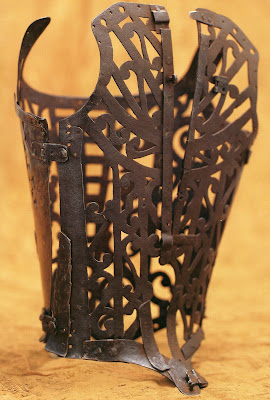
"
I would not be a Designer if I did not maintain (and it would not be difficult for me to prove) that Design is the basis and Foundation of Embroidery."
Charles Germain de Saint-Aubin, Designer for King Louis XV, 1770
In the 18th Century, embroidery was an essential decorative element for both men's and women's fashions. Techniques using silk, metal threads, spangles, quilting, and whitework were often all incorporated into a single garment.
Title: 18th Century Embroidery TechniquesAuthor: Gail Marsh
Publisher: Guild of Master Craftsman Publications Ltd., East Sussex, UK, 2006
Number of Pages: 192
Price: US$24.95, Canada $32.95
Category: Non-fiction, instructional
What it is about:Gail Marsh compiled ten volumes of research when she did a Master of Arts degree on 18th century embroidery techniques (
I wish I could do that!). This book is a culmination of that research.
Laid out like an instruction book, Marsh also provides a history of 18th century embroidery tools and techniques with accompanying photos and illustrations.
Why I Chose this Book:I'd like to incorporate embroidery into my textile art, but I have yet another of mental block on how to get started (
seems like I have a few of those LOL). Last summer, while at the
Victoria and Albert Museum's giftshop, I purchased a small embroidery kit. I thought I might try it on the plane ride home, but it ended up in my suitcase since embroidery scissors are not allowed in the cabin. And wouldn't my luck be that the embroidery hoop broke in my suitcase...
After seeing Marie Antoinette's dress at the
Royal Ontario Museum in the fall of 2008 (see my
fashion blog for photos), I was enchanted by the exquisite embroidery on the train of the dress and my desire to learn embroidery returned. I tried to find an embroidery class in Toronto but that was a dead end!
Guess where I'll be learning embroidery? At a workshop in Paris in May. But in the meantime, I really should practice at least some of the basics and hence, I read this book very carefully.
Rating: AThe book is thoughtfully laid out with clear instructions, colour photos and simple line-drawings. The author adds interest and charm to her instructions with quotes from diaries and writings of the period, such as this:
Felix Hezecques, Souvenir d'un Page de la Cour de Louis XVI, circa 1780
"
In the morning the King wore a grey coat until it was time for his toilette. Then he put on a cloth suit, often brown, with a steel or silver sword. But on Sundays and ceremonial occassions his suits were of very beautiful materials, embroidered in silks and paillettes, often, as the fashion was then, the velvet coat was entirely covered with little spangles which made it very dazzling." (page 43)
I am embarrassed to say that I have STILL not tried to embroider anything. I'm almost more intimidated than less after reading this book. The workmanship from the 18th century is so exquisite that I just know I'll never measure up.
Nevertheless, this book is a useful resource for anyone interested in historical fashion, costume design, and of course, embroidery.
























